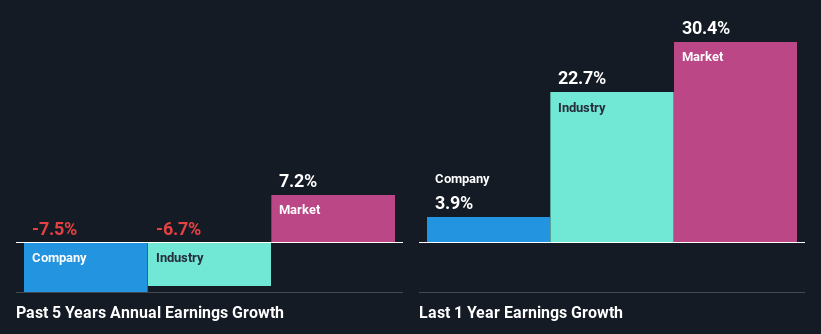Henry Boot PLC (LON:BOOT) Is Up But Financials Look Inconsistent: Which Way Is The Stock Headed?
Henry Boot's (LON:BOOT) stock up by 10.0% over the past three months. However, the company's financials look a bit inconsistent and market outcomes are ultimately driven by long-term fundamentals, meaning that the stock could head in either direction. In this article, we decided to focus on Henry Boot's ROE.
Return on equity or ROE is an important factor to be considered by a shareholder because it tells them how effectively their capital is being reinvested. Put another way, it reveals the company's success at turning shareholder investments into profits.
Check out our latest analysis for Henry Boot
How Is ROE Calculated?
The formula for ROE is:
Return on Equity = Net Profit (from continuing operations) ÷ Shareholders' Equity
So, based on the above formula, the ROE for Henry Boot is:
8.2% = UK£28m ÷ UK£341m (Based on the trailing twelve months to June 2021).
The 'return' is the amount earned after tax over the last twelve months. One way to conceptualize this is that for each £1 of shareholders' capital it has, the company made £0.08 in profit.
Why Is ROE Important For Earnings Growth?
Thus far, we have learned that ROE measures how efficiently a company is generating its profits. Based on how much of its profits the company chooses to reinvest or "retain", we are then able to evaluate a company's future ability to generate profits. Assuming everything else remains unchanged, the higher the ROE and profit retention, the higher the growth rate of a company compared to companies that don't necessarily bear these characteristics.
Henry Boot's Earnings Growth And 8.2% ROE
At first glance, Henry Boot's ROE doesn't look very promising. Yet, a closer study shows that the company's ROE is similar to the industry average of 9.6%. But then again, Henry Boot's five year net income shrunk at a rate of 7.5%. Remember, the company's ROE is a bit low to begin with. So that's what might be causing earnings growth to shrink.
From the 6.7% decline reported by the industry in the same period, we infer that Henry Boot and its industry are both shrinking at a similar rate.
Earnings growth is a huge factor in stock valuation. What investors need to determine next is if the expected earnings growth, or the lack of it, is already built into the share price. This then helps them determine if the stock is placed for a bright or bleak future. One good indicator of expected earnings growth is the P/E ratio which determines the price the market is willing to pay for a stock based on its earnings prospects. So, you may want to check if Henry Boot is trading on a high P/E or a low P/E, relative to its industry.
Is Henry Boot Using Its Retained Earnings Effectively?
Looking at its three-year median payout ratio of 30% (or a retention ratio of 70%) which is pretty normal, Henry Boot's declining earnings is rather baffling as one would expect to see a fair bit of growth when a company is retaining a good portion of its profits. So there could be some other explanations in that regard. For instance, the company's business may be deteriorating.
Moreover, Henry Boot has been paying dividends for at least ten years or more suggesting that management must have perceived that the shareholders prefer dividends over earnings growth. Our latest analyst data shows that the future payout ratio of the company over the next three years is expected to be approximately 29%. Accordingly, forecasts suggest that Henry Boot's future ROE will be 9.5% which is again, similar to the current ROE.
Conclusion
In total, we're a bit ambivalent about Henry Boot's performance. While the company does have a high rate of reinvestment, the low ROE means that all that reinvestment is not reaping any benefit to its investors, and moreover, its having a negative impact on the earnings growth. That being so, the latest industry analyst forecasts show that the analysts are expecting to see a huge improvement in the company's earnings growth rate. Are these analysts expectations based on the broad expectations for the industry, or on the company's fundamentals? Click here to be taken to our analyst's forecasts page for the company.
This article by Simply Wall St is general in nature. We provide commentary based on historical data and analyst forecasts only using an unbiased methodology and our articles are not intended to be financial advice. It does not constitute a recommendation to buy or sell any stock, and does not take account of your objectives, or your financial situation. We aim to bring you long-term focused analysis driven by fundamental data. Note that our analysis may not factor in the latest price-sensitive company announcements or qualitative material. Simply Wall St has no position in any stocks mentioned.
Have feedback on this article? Concerned about the content? Get in touch with us directly. Alternatively, email editorial-team (at) simplywallst.com.

 Yahoo Finance
Yahoo Finance 
